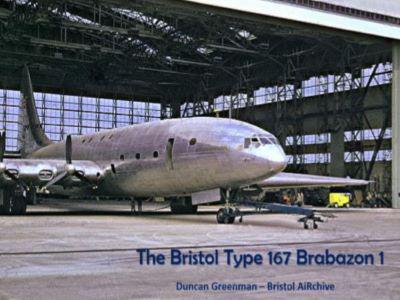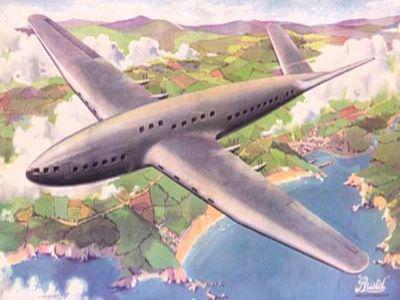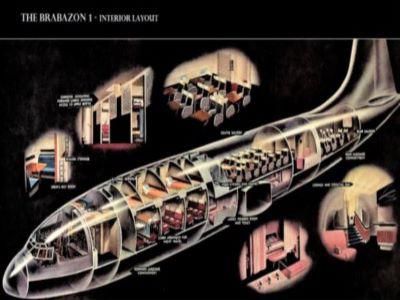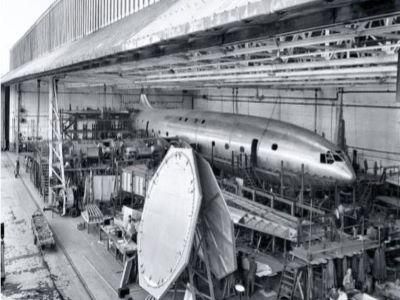In case you missed it see what’s in this section
Let's Talk
Your Total Guide To community

70th anniversary of the Brabazon
Wednesday 4th September marked the 70th anniversary of the first flight of the Bristol Brabazon aeroplane from Filton Airfield (4th September 1949). While only one complete example of the huge aircraft was ever built (and that has since been scrapped), there are some Brabazon parts – including a propeller and wheels - in the exhibition at Aerospace Bristol, as well as a scale model of the aircraft. There are also plans to develop the airfield into a residential and commercial area known as Brabazon.
Here is some information on Brabazon that a volunteer at Aerospace Bristol put together;
Background
On 8 March 1910, John Moore-Brabazon became the first person to qualify as a pilot in the United Kingdom and was awarded Royal Aero Club Aviator's Certificate number 1. When his friend C.S. Rolls was killed in a flying accident later in 1910, Moore-Brabazon's wife persuaded him to give up flying. However, he remained very visible in aviation and also motor car and sail/motor-boat racing. He joined the RFC in 1915 in a ground-based role, but it was as a Member of Parliament after 1918 that he grew to prominence, becoming Minister of Transport in 1940.
In 1942, he was tasked with setting up a technical committee to investigate the post-WW2 needs of the British Empire's civilian airliner market. Brabazon’s Committee was formed on 23rd December 1942 and consisted of many of the “great and good” associated with the aircraft industry of the time.
In 1942, the UK and the USA had agreed to split responsibility for building multi-engine aircraft types – the UK focus was on bombers, with transport aircraft being left to the USA. It was soon recognized that as a result of that decision the UK could be left at the end of the war with little experience in the design, manufacture and final assembly of transport aircraft; in addition, it would have little or no infrastructure or trained personnel for doing it.
The Brabazon study was tasked to define, in broad overview, the impact of projected advances in aviation technology and to forecast the global needs of the post war British Empire (in South Asia, Africa, the Near and Far East) and the Commonwealth (Australia, Canada, New Zealand) in the area of air transport, for passengers, mail, and cargo.
The study recognized that the British Empire and Commonwealth, as both a political and economic entity, would have a vital need for aviation systems (principally aircraft) to facilitate its continued existence and self-reliance in the post-war world. For military and commercial reasons, the Empire simply could not continue to exist if it did not understand these needs, and develop the industrial infrastructure to provide the aviation systems and sub-systems necessary to supply and maintain a global air transport service.
The Committee first convened in February 1943, meeting several times over the next two years to further clarify the needs of different market segments. The final report called for the construction of four general designs, identified by the committee and members of the state-owned airlines British Overseas Airways Corporation (BOAC) and later British European Airways (BEA); a fifth type was added later.
The Five types of “Brabazon” aircraft;
1. Type I was a very large luxury transatlantic airliner serving the high-volume routes like London New York.
2. Type II was a short haul feederliner intended to replace the Douglas DC-3; the Type IIA was to be a piston-powered aircraft, the Type IIB would have turbine engines (not developed by then).
3. Type III called for a larger medium-range aircraft serving the British Empire IIIA was to be a piston–powered aircraft, the Type IIIB would have turbine engines.
4. Type IV jet-powered 100-seat design to eventually replace the Type III.
5. Type V was later introduced to fill the original feederliner specifications after the Type II had evolved into larger designs.
The Bristol 100-ton Bomber
In late-1942, the Filton design offices were working on a 5,000 mile range bomber which became known as the Bristol 100-ton bomber. It required many times the power of the Lancaster, to be provided by eight 2800 hp Bristol Centaurus engines – the most powerful around at the time. This concept had pusherengines mounted in coupled pairs and buried in the wing to reduce drag.
When the initial Brabazon findings were published, Bristol responded by submitting a slightly modified version of their bomber to meet the needs for the Type I requirement. As Bristol's earlier work had shown the performance the Brabazon Committee has been seeking, the Company was authorised to proceed with preliminary design work, on the proviso that work on wartime aircraft was not disrupted. A contract to produce a pair of prototype aircraft was issued and concepts for the Bristol Type 167 Brabazon Type 1 started to be published through Bristol-drawn advertisements appearing in the wartime aviation press.
Also required was a large hangar and a new runway to accommodate the proposed leviathan, which would be the largest aircraft in the world. Although the Filton site had space to the north of the factory, the hamlet of Charlton would need to be mostly demolished to build the 8500 feet long runway.
The first Brabazon configuration.
An artist’s impression of Brabazon Mark 1 in civilian configuration appeared as the front cover of Flight magazine for 7th January 1944 (colour illustration on next page, reconstructed by the author). It had “pusher” engines and sported “butterfly” tail surfaces, with the engines still coupled in pairs with coaxial final drives to the 6-blade contra-rotating propellors. This enabled both propellors to keep turning should one engine fail.

The internal layout seems to date back to the Short Empire and Boeing flying boats of the late-1930s and was meant for 100 passengers, although an early version had only 64 passengers. Some of the more lavish furnishings are similar to those in today’s A380 aircraft – sleeping berth seats, the 1940’s equivalent of video screens for every seat (a dedicated cinema in Brabazon), bar/restaurant, dedicated crew sleeping cabins, etc.

Manufacturing.
The fuselage was a tight fit in the “normal” size 1930’s No.2 Flight Shed which was previously used to house Bristol Blenheim, Beaufort and Beaufighter aircraft undergoing flight testing prior to delivery. The port outer wing can be seen being built in the foreground, with two large octagonal jigs for building fuselage frames. The starboard inner wing and engine air inlets can also be clearly seen.
It was said that there was only five inches clearance between the airframe and the hangar structure when it was pulled out on 7th October 1947 and delivered to its bespoke hangars. These hangars employed enormous civil engineering resources, including an easily moveable narrow gauge railway!
Aircraft Assembly Halls (aka the Brabazon Hangars)

This photograph shows the hangars at an early stage of construction - the date is believed to be in the spring of 1947, after one of the most severe winters in living memory. Heavy rain and severe flooding affected most of the country (pre-global warming!), which made working on the 100 ft tall steel girder structure very difficult - it would be another four years before the complex of buildings would be completed.
When completed, the enormous hangar doors enclosed the largest unsupported span in the world at the time. They were made in three sections, one for each hangar bay, totalling 1045 feet in length and 65 feet 9 inches in height; each door can be opened in less than two minutes. The photograph shows the fuselage after arriving outside the partially completed East Bay on 7th October 1947.
Many interesting photographs survive of the build and testing of the first prototype but, unfortunately, space here only allows a couple to be reproduced. If you want to see more images, read the full article then click here to go to the Aerospace website.
Bill Pegg arrived at Filton from the RAF to test production RAF Blenheims in 1935. Walter Gibb DSO arrived as an apprentice in 1937, before joining the RAF in May 1940; he returned early in 1946 after a very distinguished RAF wartime career. Both men were rated by the RAF as pilots of the highest calibre – Walter went on to hold the world altitude record on two occasions, finally reaching 63,668 feet on 4th May 1953 in a Bristol Olympus powered English Electric Canberra jet bomber.
The First Flight of the World’s Biggest Aircraft – 4th September 1949
The inevitable end came in October 1953 after Brabazon G-AGPW had flown less than 400 hours; the halffinished Brabazon Mark 2 aircraft, which was to have had Bristol Proteus turbine engines, was also broken up for scrap. The lessons learnt went on to be incorporated in the Bristol Type 175 Britannia and even, so it is said, into Concorde, the last of many Filton technical wonders.
For more information on Aerospace Bristol click here.
Weather in Bristol
Listings














